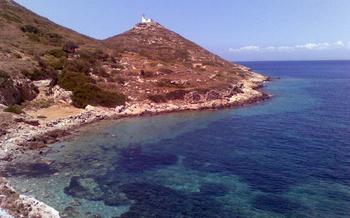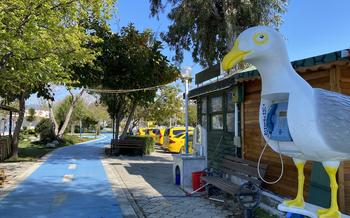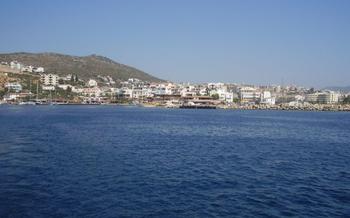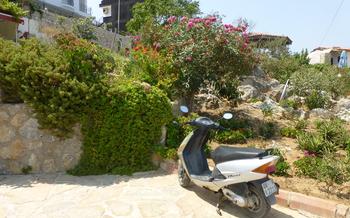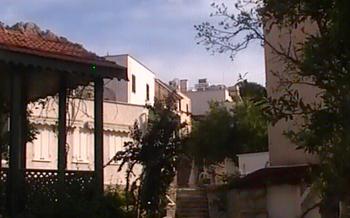
Knidos Ancient City
- Datça: A Historical Gem in Southwestern Turkey
- Unveiling the Ruins of Knidos: A Journey Through Time
- Marveling at the Odeon: A Theater for Music and Performance
- Walking the Ancient Streets: A Stroll Through History
- Discovering the Necropolis: A City of the Dead
- Admiring the Hellenistic Lighthouse: A Beacon of Hope and Navigation
- Exploring the Museum of Knidos: A Treasure Trove of History
- Relaxing on the Beaches of Datça: A Mediterranean Paradise
- Indulging in the Local Cuisine: A Culinary Adventure
- Exploring the Surrounding Area: Natural Wonders and Hidden Gems
- Planning Your Visit: Practical Tips for a Smooth Journey
- Unforgettable Experiences: Creating Lasting Memories
- Insider Tip: Exploring Knidos at Night
Datça: A Historical Gem in Southwestern Turkey
Located on the southwestern coast of Turkey, Datça is a charming town steeped in history and natural beauty. Its strategic position on the Aegean Sea has made it a significant center of trade and culture throughout the centuries. Datça boasts a rich historical heritage, dating back to ancient times when it was known as Knidos, one of the most prominent cities of the ancient world.
With its well-preserved ruins, stunning coastline, and idyllic beaches, Datça offers a captivating blend of history, culture, and natural wonders. It serves as an ideal starting point for exploring the ancient city of Knidos, a place where history comes alive, inviting visitors on a journey through time to discover the secrets of a lost civilization.
Unveiling the Ruins of Knidos: A Journey Through Time
Step into the ancient city of Knidos, where time stands still amidst the awe-inspiring ruins. Discover the remnants of a once-thriving civilization, where history unfolds with every step.
Knidos, with its deep-rooted historical significance, dates back to the 7th century BC. As you wander through the ruins, marvel at the architectural marvels that have withstood the test of time. Well-preserved structures, including the city walls, temples, and theaters, offer a glimpse into the lives of the ancient inhabitants.
Archaeological excavations continue to unveil the secrets of Knidos, revealing new insights into the city's rich past. Unearthed artifacts, such as pottery, sculptures, and coins, shed light on the daily lives, customs, and beliefs of this ancient civilization.
As you explore the ruins, let your imagination transport you back in time. Picture the bustling streets filled with merchants, philosophers, and sailors, each playing a role in the vibrant tapestry of Knidos's history.
Marveling at the Odeon: A Theater for Music and Performance
The Odeon of Knidos stands as a testament to the city's vibrant cultural life and appreciation for the arts. This ancient theater, dedicated to musical performances and entertainment, served as a gathering place for the community to experience the magic of music, drama, and poetry.
Built in the 4th century BC, the Odeon boasts an impressive design that enhances its acoustics and creates an immersive atmosphere for its audience. The theater's carefully crafted seating arrangement ensures that every spectator enjoys optimal sound quality, allowing them to fully appreciate the performances taking place on stage.
Within the Odeon's walls, a variety of performances were held, from musical concerts and theatrical plays to poetry recitals and dance performances. The theater's stage hosted renowned musicians, actors, and performers from across the ancient world, who captivated audiences with their talent and artistry.
Attending an event at the Odeon was a significant social occasion for the people of Knidos. It provided an opportunity for them to come together, share in the collective experience of live entertainment, and celebrate the power of the arts. The Odeon served as a hub for cultural exchange and artistic expression, fostering a sense of community and enriching the lives of its citizens.
Walking the Ancient Streets: A Stroll Through History
Meandering through the ancient streets of Knidos is akin to embarking on a journey through time. The city's well-preserved streets, lined with the vestiges of ancient buildings, offer a glimpse into the daily life and culture of this once-thriving metropolis.
The streets are narrow and winding, reflecting the architectural style of ancient Greek cities. The buildings are constructed from local stone, their facades adorned with intricate carvings and decorative elements. Shops, markets, and public spaces once bustled with activity, forming the vibrant heart of the city.
As you walk, imagine the sounds of merchants hawking their wares, the laughter of children playing in the streets, and the lively chatter of citizens going about their daily lives. The streets served as a meeting place, a marketplace, and a stage for social interaction in ancient Knidos.
Walking these ancient streets is a truly immersive experience, transporting you back to a time when Knidos was a thriving center of commerce, culture, and civilization. It's an opportunity to connect with the past and gain a deeper appreciation for the rich history and heritage of this remarkable ancient city.
Discovering the Necropolis: A City of the Dead
The necropolis, or the city of the dead, holds a significant place in ancient Greek culture. It was a sacred area where the deceased were laid to rest with great care and respect. In Knidos, the necropolis is located just outside the city walls, along the slopes of a hill. It offers a fascinating glimpse into the burial practices and beliefs of the ancient Knidians.
Various types of tombs can be found in the Knidos necropolis. The most common are chamber tombs, which consist of a small chamber carved into the rock, where the deceased was laid to rest along with their grave goods. Some tombs feature elaborate facades and inscriptions, providing valuable insights into the lives and families of the deceased.
One of the most notable tombs is the Lion Tomb. It is a large, impressive structure adorned with a majestic lion, symbolizing strength and courage. The tomb dates back to the 4th century BC and is believed to have belonged to a wealthy and influential family.
The necropolis also includes a number of collective tombs, where multiple individuals were buried together. These tombs often belonged to families or groups who shared a common bond. The presence of these collective tombs sheds light on the social and familial structures of ancient Knidos.
Exploring the necropolis provides a unique opportunity to learn about the beliefs and rituals surrounding death and the afterlife in ancient Greece. It is a place where the past and the present intertwine, offering a glimpse into the lives and customs of a long-lost civilization.
Admiring the Hellenistic Lighthouse: A Beacon of Hope and Navigation
Standing proudly on the southernmost tip of the Datça Peninsula, the Hellenistic Lighthouse of Knidos stands as a testament to the ingenuity and maritime prowess of the ancient Greeks. Built in the 3rd century BC, this lighthouse served as a guiding beacon for ships navigating the treacherous waters of the Aegean Sea. The lighthouse's design was revolutionary for its time, featuring a multi-tiered tower with a central staircase and an ingenious system of oil lamps and mirrors to amplify the light's reach.
The Knidos Lighthouse was not just a navigational aid but also a symbol of the city's wealth and power. Its strategic location allowed Knidos to control maritime trade routes and collect substantial tolls from passing ships. The lighthouse's construction required immense resources and engineering expertise, demonstrating Knidos's status as a major maritime hub.
Over the centuries, the lighthouse has undergone significant restoration efforts, ensuring its preservation for future generations. Visitors can climb the tower's winding staircase to reach the top and enjoy breathtaking panoramic views of the surrounding landscape. The lighthouse's enduring presence serves as a reminder of the ingenuity and maritime achievements of the ancient Greeks, who left an indelible mark on the history of navigation.
Exploring the Museum of Knidos: A Treasure Trove of History
Housed in a historic building within the ancient city, the Museum of Knidos is a treasure trove of artifacts and exhibits that shed light on the rich history and culture of Knidos. Its collection spans from the prehistoric era to the Hellenistic and Roman periods, offering visitors a glimpse into the artistic, cultural, and everyday life of this ancient city.
The museum's exhibits include an impressive array of sculptures, pottery, jewelry, and other relics excavated from Knidos and its surroundings. Among the highlights are the famous "Knidos Aphrodite," a marble statue of the goddess of love and beauty, and the "Lion Tomb," an elaborate mausoleum adorned with intricate carvings of lions. These masterpieces provide a glimpse into the artistic prowess and cultural significance of Knidos in the ancient world.
In addition to these remarkable artifacts, the museum also houses a collection of coins, inscriptions, and everyday objects that offer insights into the economic, social, and political aspects of life in ancient Knidos. Visitors can learn about the city's trade relations, its system of government, and the daily lives of its inhabitants.
The Museum of Knidos is a must-visit for anyone interested in the history and culture of this ancient city. Its collection provides a tangible connection to the past, allowing visitors to experience the rich legacy of Knidos firsthand.
Relaxing on the Beaches of Datça: A Mediterranean Paradise
After exploring the ancient ruins of Knidos, unwind and rejuvenate your senses on the picturesque beaches of Datça. Immerse yourself in the crystal-clear waters of the Mediterranean Sea, bask in the warm sunshine, and let the gentle sea breeze caress your skin. Indulge in swimming, snorkeling, diving, or simply soak up the sun's rays on the golden sands.
Discover secluded coves and hidden bays, perfect for escaping the crowds and finding your own slice of paradise. Immerse yourself in the breathtaking beauty of the coastline, where turquoise waters meet rugged cliffs, creating a landscape that will leave you spellbound.
As the day draws to a close, find a spot on the beach and witness the mesmerizing sunset over the Mediterranean Sea. The sky transforms into a canvas of vibrant colors, casting a warm glow on the ancient ruins of Knidos, creating a magical and unforgettable moment.
Whether you're seeking adventure, relaxation, or simply a chance to reconnect with nature, the beaches of Datça offer an idyllic escape. Embrace the Mediterranean lifestyle and create lasting memories in this coastal paradise.
Indulging in the Local Cuisine: A Culinary Adventure
Datça and its surrounding area offer a delectable culinary experience, tantalizing the taste buds with fresh seafood and traditional Turkish dishes. Seafood enthusiasts will delight in the daily catch, including grilled fish, calamari, and succulent shrimp, served with simple yet flavorful accompaniments.
For a taste of local specialties, try the gözleme, a savory pastry filled with spinach, cheese, or minced meat, or the pişi, a deep-fried dough that pairs perfectly with a cup of Turkish tea. Indulge in the meze platter, a selection of small dishes such as hummus, baba ghanoush, and stuffed grape leaves, perfect for sharing and sampling the region's diverse flavors.
Waterfront restaurants line the coast, offering stunning views of the Mediterranean Sea as you savor your meal. Enjoy the freshest seafood delicacies while basking in the beauty of the surrounding landscape.
The culinary traditions of Datça are influenced by its historical and geographical location, blending Turkish, Greek, and Mediterranean flavors. Freshly grown produce, herbs, and spices add a unique touch to local dishes, creating a tantalizing fusion of flavors.
Embark on a culinary adventure in Datça, where every meal is a celebration of taste and tradition. Immerse yourself in the local cuisine and discover the hidden gems that await your palate.
Exploring the Surrounding Area: Natural Wonders and Hidden Gems
Beyond the ancient city of Knidos, the Datça Peninsula offers a wealth of natural wonders and hidden gems waiting to be discovered. Embark on a day trip to the nearby islands of Simi and Kos, each with its unique charm and historical heritage. Immerse yourself in the breathtaking scenery of the Datça Peninsula by embarking on scenic walks or challenging hiking trails. Discover hidden coves, cascading waterfalls, and natural landmarks that will leave you in awe of nature's artistry. Embrace the diversity of the region by exploring its rich flora and fauna, encountering rare and endangered species that call this peninsula their home. Whether you seek adventure, tranquility, or a deeper connection with nature, the surrounding area of Knidos and Datça promises unforgettable experiences.
Planning Your Visit: Practical Tips for a Smooth Journey
To ensure a seamless and fulfilling visit to Knidos and Datça, careful planning is essential. Here are some practical tips to help you make the most of your trip:
Best Time to Visit: Spring (April-May) and autumn (September-October) offer pleasant weather, ideal for exploring the ruins and enjoying outdoor activities. Summer months can be hot and crowded, while winters are mild but may have limited accessibility due to weather conditions.
Transportation: Knidos is accessible by road from Datça, which is well-connected by bus to major cities in Turkey. Once in Datça, local transportation options include taxis, dolmuş (shared minibuses), and rental cars. Exploring the surrounding area is best done with a rental car or by joining organized tours.
Accommodation and Dining: Datça offers a range of accommodation options, from budget guesthouses to comfortable hotels. For a unique experience, consider staying in a traditional stone house or a charming boutique hotel. Dining options are plentiful, with fresh seafood, traditional Turkish dishes, and international cuisine available.
Essential Items: Pack comfortable walking shoes, sunscreen, a hat, and a refillable water bottle. A camera is a must to capture the stunning scenery and ancient ruins. Consider bringing a flashlight or headlamp for exploring the necropolis or Knidos at night.
Precautions: Be mindful of the sun, especially during the summer months. Stay hydrated and wear appropriate clothing. Respect local customs and dress modestly when visiting religious sites or conservative areas.
Unforgettable Experiences: Creating Lasting Memories
Visiting Knidos and Datça offers a myriad of opportunities to create unforgettable experiences that will stay with you long after you return home. As the sun begins to set, the ancient ruins take on a magical aura, casting long shadows and creating a breathtaking spectacle. Don't miss the chance to witness this awe-inspiring sight as the sky transforms into a canvas of vibrant hues.
Embark on a boat tour to explore the stunning coastline and hidden bays that dot the peninsula. Discover secluded coves, pristine beaches, and crystal-clear waters, perfect for swimming, snorkeling, or simply relaxing on the deck and soaking up the Mediterranean sun.
Throughout the year, Datça and the surrounding area host a variety of cultural events and festivals that celebrate the region's rich heritage and traditions. Immerse yourself in the vibrant atmosphere of these events, where you can witness traditional dances, listen to live music, sample local delicacies, and learn about the unique customs of the region.
Take the time to connect with the locals and learn about their way of life. Engage in conversations, visit local markets, and savor the flavors of traditional Turkish cuisine. Embrace the warmth and hospitality of the people of Datça, who are always eager to share their culture and traditions with visitors.
Insider Tip: Exploring Knidos at Night
While the ancient city of Knidos is captivating during the day, it transforms into a realm of magic and wonder under the moonlight. As the sun sets and the crowds disperse, a different side of Knidos emerges. The ancient ruins take on a new aura, casting long shadows that create an ethereal and mysterious atmosphere.
Exploring Knidos at night offers a unique and unforgettable experience. With fewer visitors around, you can immerse yourself in the tranquility of the ancient city and appreciate its beauty without the hustle and bustle of the daytime. The lack of crowds also allows you to take your time, wander through the ruins at your own pace, and capture stunning photographs without distractions.
As you stroll along the ancient streets, illuminated by the soft glow of the moonlight, imagine the city's inhabitants going about their daily lives centuries ago. Let your mind wander as you picture the bustling marketplace, the lively theater performances, and the sacred rituals held in the temple of Aphrodite. The night silence amplifies the sounds of the waves crashing against the shore, creating a mesmerizing symphony that echoes through the ruins.
If you're fortunate enough to visit Knidos during a clear night, take advantage of the opportunity to stargaze. With minimal light pollution, the night sky reveals its full splendor, showcasing countless stars and constellations. Find a spot away from the city lights and lie down on the ancient stones, marveling at the celestial wonders above.
Exploring Knidos at night is a truly magical experience that allows you to connect with the ancient city on a deeper level. Whether you're a history buff, a nature lover, or simply seeking a unique and awe-inspiring adventure, a nocturnal visit to Knidos is sure to leave an unforgettable mark on your memory.
